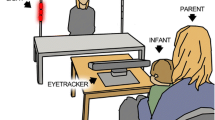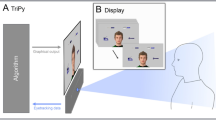Abstract
The main purpose of this eye tracking study was to map the correlates of gaze performance in a brief test of spontaneous gaze and point-gesture following in young children with autistic disorder (AD), Pervasive developmental disorder—not otherwise specified (PDD-NOS), or typical development (TD). Gaze measures included the children’s spontaneous tendency to look at the correct (attended) toy, and the latency of their correct responses. In addition to group differences (AD vs. TD), we found that in AD, accuracy of performance was specifically related to adaptive communication skills. The study also indicated that the latency of correct gaze shifts is related to verbal intelligence. These results have direct implications for our understanding of (responsive) joint attention impairments in AD.


Similar content being viewed by others
References
Akechi, H., Senju, A., Kikuchi, Y., Tojo, Y., Osanai, H., & Hasegawa, T. (2011). Do children with ASD use referential gaze to learn the name of an object? An eye-tracking study. Research in Autism Spectrum Disorders, 5(3), 1230–1242. doi:10.1016/j.rasd.2011.01.013.
American Psychiatric Association. (1994). Diagnostic and statistical manual of mental disorders (4th ed.). Washington DC: American Psychiatric Association.
Baldwin, D. A. (1991). Infants contribution to the achievement of joint reference. Child Development, 62(5), 875–890. doi:10.2307/1131140.
Baron-Cohen, S., Allen, J., & Gillberg, C. (1992). Can autism be detected at 18 months: The needle, the haystack, and the CHAT. British Journal of Psychiatry, 161, 839–843.
Baron-Cohen, S., Campbell, R., Karmiloffsmith, A., Grant, J., & Walker, J. (1995). Are children with autism blind to the mentalistic significance of the eyes. British Journal of Developmental Psychology, 13, 379–398.
Carpenter, M., Pennington, B. F., & Rogers, S. J. (2002). Interrelations among social-cognitive skills in young children with autism. Journal of Autism and Developmental Disorders, 32(2), 91–106.
Chawarska, K., Klin, A., & Volkmar, F. (2003). Automatic attention cueing through eye movement in 2-year-old children with autism. [Proceedings Paper]. Child Development, 74(4), 1108.
Coleman, M., & Gillberg, C. (2012). The Autisms (4th ed.). New York: Oxford University Press.
Falck-Ytter, T. (2010). Young children with autism spectrum disorder use predictive eye movements in action observation. Biology Letters, 6(3), 375–378.
Falck-Ytter, T., Fernell, E., Gillberg, C., & von Hofsten, C. (2010). Face scanning distinguishes social from communication impairments in autism. Developmental Science, 13(6), 864–865.
Falck-Ytter, T., & von Hofsten, C. (2011). How special is social looking in ASD: A review. In O. J. Braddick, J. Atkinson, & G. Innocenti (Eds.), Progress in Brain Research (vol. 198).
Fernell, E., Hedvall, A., Norrelgen, F., Eriksson, M., Hoglund-Carlsson, L., Barnevik-Olsson, M., et al. (2010). Developmental profiles in preschool children with autism spectrum disorders referred for intervention. Research in Developmental Disabilities, 31(3), 790–799. doi:10.1016/j.ridd.2010.02.003.
Fernell, E., Hedvall, A., Westerlund, J., Carlsson, L. H., Eriksson, M., Olsson, M. B., et al. (2011). Early intervention in 208 Swedish preschoolers with autism spectrum disorder. A prospective naturalistic study. Research in Developmental Disabilities, 32(6), 2092–2101. doi:10.1016/j.ridd.2011.08.002.
Freeth, M., Chapman, P., Ropar, D., & Mitchell, P. (2010). Do gaze cues in complex scenes capture and direct the attention of high functioning adolescents with ASD? Evidence from eye-tracking. Journal of Autism and Developmental Disorders, 40(5), 534–547. doi:10.1007/s10803-009-0893-2.
Gliga, T., Elsabbagh, M., Hudry, K., Charman, T., & Johnson, M. H. (in press). Gaze following, gaze reading, and word learning in children at-risk for autism. Child Development.
Hobson, R. P. (1993). The emotional origins of social understanding. Philosophical Psychology, 6(3), 227–249. doi:10.1080/09515089308573090.
Krug, D. A., Arick, J., & Almond, P. (1980). Behavior checklist for identifying severely handicapped individuals with high-levels of autistic behavior. Journal of Child Psychology and Psychiatry and Allied Disciplines, 21(3), 221–229.
Leekam, S. R., Hunnisett, E., & Moore, C. (1998). Targets and cues: Gaze-following in children with autism. Journal of Child Psychology and Psychiatry and Allied Disciplines, 39(7), 951.
Leekam, S. R., Lopez, B., & Moore, C. (2000). Attention and joint attention in preschool children with autism. Developmental Psychology, 36(2), 261–273.
Leekam, S. R., & Ramsden, C. A. H. (2006). Dyadic orienting and joint attention in preschool children with autism. Journal of Autism and Developmental Disorders, 36(2), 185–197. doi:10.1007/s10803-005-0054-1.
Lord, C., Risi, S., Lambrecht, L., Cook, E. H., Leventhal, B. L., DiLavore, P. C., et al. (2000). The autism diagnostic observation schedule-generic: A standard measure of social and communication deficits associated with the spectrum of autism. Journal of Autism and Developmental Disorders, 30(3), 205–223.
Mundy, P. (1995). Joint attention and social-emotional approach behavior in children with autism. Development and Psychopathology, 7(1), 63–82.
Mundy, P., Sigman, M., Ungerer, J., & Sherman, T. (1986). Defining the social deficits of autism: The contribution of non-verbal communication measures. Journal of Child Psychology and Psychiatry, 27(5), 657–669.
Nation, K., & Penny, S. (2008). Sensitivity to eye gaze in autism: Is it normal? Is it automatic? Is it social? Development and Psychopathology, 20(1), 79.
Nordin, V., & Gillberg, C. (1996). Autism spectrum disorders in children with physical or mental disability or both.2. Screening aspects. Developmental Medicine and Child Neurology, 38(4), 314–324.
Nygren, G., Hagberg, B., Billstedt, E., Skoglund, A., Gillberg, C., & Johansson, M. (2009). The Swedish version of the diagnostic interview for social and communication disorders (DISCO-10). Psychometric properties. Journal of Autism and Developmental Disorders, 39, 730–741.
Senju, A., Tojo, Y., Dairoku, H., & Hasegawa, T. (2004). Reflexive orienting in response to eye gaze and an arrow in children with and without autism. Journal of Child Psychology and Psychiatry, 45(3), 445–458.
Sparrow, S. S., Cicchetti, D. V., & Balla, D. A. (2005). Vineland adaptive behavior scales, second edition, survey interview form/caregiver rating form. Livonia: Pearson Assessment.
Sullivan, M., Finelli, J., Marvin, A., Garrett-Mayer, E., Bauman, M., & Landa, R. (2007). Response to joint attention in toddlers at risk for autism spectrum disorder: A prospective study. Journal of Autism and Developmental Disorders, 37(1), 37.
von Hofsten, C., Dahlstrom, E., & Fredriksson, Y. (2005). 12-month-old infants’ perception of attention direction in static video images. Infancy, 8(3), 217–231.
Wechsler, D. (1967/2002). Wechsler preshcool and primary scale of intelligence—Third edition (WPPSI—III). San Antonio: Harcourt Assessment.
Wing, L., Gould, J., & Gillberg, C. (2011). Autism spectrum disorders in the DSM-V: Better or worse than the DSM-IV? Research in Developmental Disabilities, 32(2), 768–773.
Acknowledgments
This study was supported by grants to CvH from the Tercentennial Fund of the Bank of Sweden (P09-0933:1) and from the Norwegian Directorate for Children, Youth, and Family Affairs (06/34707), to EF from the Swedish Inheritance Fund and to CG from Gothenburg University. The work of TFY and CvH was supported by the ESF COST Action BM1004 Enhancing the Scientific Study of Early Autism (ESSEA).
Author information
Authors and Affiliations
Corresponding author
Rights and permissions
About this article
Cite this article
Falck-Ytter, T., Fernell, E., Hedvall, Å.L. et al. Gaze Performance in Children with Autism Spectrum Disorder when Observing Communicative Actions. J Autism Dev Disord 42, 2236–2245 (2012). https://doi.org/10.1007/s10803-012-1471-6
Published:
Issue Date:
DOI: https://doi.org/10.1007/s10803-012-1471-6




